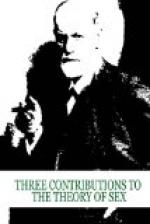If we might assume that the same erogenous action also reaches the intensive painful feelings, especially if the pain be toned down or held at a distance by a subsidiary determination, this relation would then contain the main roots of the masochistic-sadistic impulse, into the manifold composition of which we are gaining a gradual insight.
Intellectual Work.—Finally, is is evident that mental application or the concentration of attention on an intellectual accomplishment will result, especially often in youthful persons, but in older persons as well, in a simultaneous sexual excitement, which may be looked upon as the only justified basis for the otherwise so doubtful etiology of nervous disturbances from mental “overwork.”
If we now, in conclusion, review the evidences and indications of the sources of the infantile sexual excitement, which have been reported neither completely nor exhaustively, we may lay down the following general laws as suggested or established. It seems to be provided in the most generous manner that the process of sexual excitement—the nature of which certainly remains quite mysterious to us—should be set in motion. The factor making this provision in a more or less direct way is the excitation of the sensible surfaces of the skin and sensory organs, while the most immediate exciting influences are exerted on certain parts which are designated as erogenous zones. The criterion in all these sources of sexual excitement is really the quality of the stimuli, though the factor of intensity (in pain) is not entirely unimportant. But in addition to this there are arrangements in the organism which induce sexual excitement as a subsidiary action in a large number of inner processes as soon as the intensity of these processes has risen above certain quantitative limits. What we have designated as the partial impulses of sexuality are either directly derived from these inner sources of sexual excitation or composed of contributions from such sources and from erogenous zones. It is possible that nothing of any considerable significance occurs in the organism that does not contribute its components to the excitement of the sexual impulse.
It seems to me at present impossible to shed more light and certainty on these general propositions, and for this I hold two factors responsible; first, the novelty of this manner of investigation, and secondly, the fact that the nature of the sexual excitement is entirely unfamiliar to us. Nevertheless, I will not forbear speaking about two points which promise to open wide prospects in the future.
Diverse Sexual Constitutions.—(a) We have considered above the possibility of establishing the manifold character of congenital sexual constitutions through the diverse formation of the erogenous zones; we may now attempt to do the same in dealing with the indirect sources of sexual excitement. We may assume that, although these different sources furnish contributions in all individuals, they are not all equally strong in all persons; and that a further contribution to the differentiation of the diverse sexual constitution will be found in the preferred developments of the individual sources of sexual excitement.




